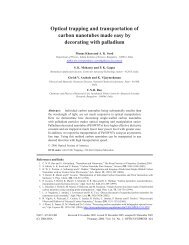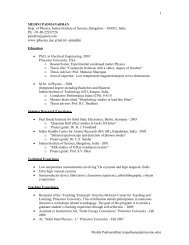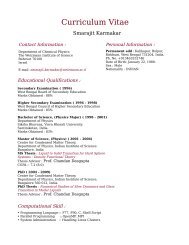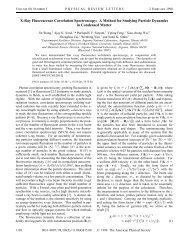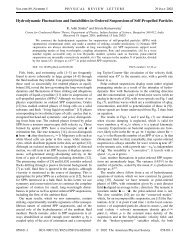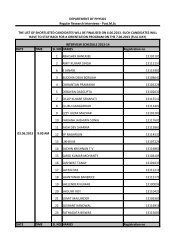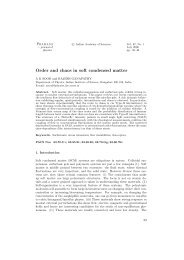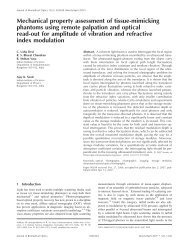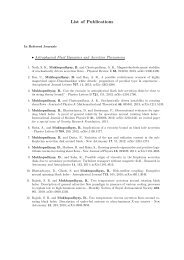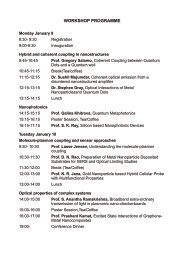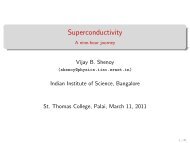Thermoelectric Properties of Fe0.2Co3.8Sb12-xTex ... - Physics
Thermoelectric Properties of Fe0.2Co3.8Sb12-xTex ... - Physics
Thermoelectric Properties of Fe0.2Co3.8Sb12-xTex ... - Physics
You also want an ePaper? Increase the reach of your titles
YUMPU automatically turns print PDFs into web optimized ePapers that Google loves.
<strong>Thermoelectric</strong> properties <strong>of</strong> chalcogenide based Cu 2+x ZnSn 1-x Se 4<br />
Ch. Raju a , M. Falmbigl b , P. Rogl b , X. Yan c , E. Bauer c , J. Horky d , M. Zehetbauer d ,<br />
and Ramesh Chandra Mallik a*<br />
a<br />
Department <strong>of</strong> <strong>Physics</strong>, Indian Institute <strong>of</strong> Science, Bangalore 560012, India<br />
b<br />
Institute <strong>of</strong> Physical Chemistry, University <strong>of</strong> Vienna, Währingerstrasse 42, A-1090 Wien, Austria<br />
c<br />
Institute <strong>of</strong> Solid State <strong>Physics</strong>, TU Vienna, Wiedner Hauptstrasse 8-10, A-1040 Wien, Austria<br />
d<br />
Research Group <strong>Physics</strong> <strong>of</strong> Nanostructures Materials, University <strong>of</strong> Vienna, Boltzmanngasse 5,<br />
Abstract:<br />
A-1090 Wien, Austria<br />
Quaternary chalcogenide compounds Cu 2+x ZnSn 1-x Se 4 (x=0, 0.025, 0.05, 0.75, 0.1, 0.125, 0.15)<br />
were prepared by solid state synthesis. The structural and phase identification <strong>of</strong> these<br />
compounds were studied by Rietveld X-ray powder diffraction (XPD) refinement combined with<br />
Electron Probe Micro Analyzes (EPMA). The XPD patterns <strong>of</strong> all samples showed a stannite<br />
phase isotypic with the tetragonal Cu 2 FeSnS 4 -type including ZnSe as a secondary phase. The<br />
samples with the highest Cu-content (x=0.125, 0.15) contained CuSe and SnSe as secondary<br />
phases in addition to ZnSe. Raman spectroscopy was employed for the phase identification in<br />
order to resolve Cu 2 ZnSnSe 4 and ZnSe phase contents, because XPD patterns <strong>of</strong> both the phases<br />
overlap. In all samples the presence <strong>of</strong> vibrational modes corresponding to Cu 2 ZnSnSe 4 were<br />
observed and confirm the stannite phase. The electrical resistivity, Seebeck coefficient and<br />
thermal conductivity measurements were carried out as a function <strong>of</strong> temperature in the range<br />
300-720K. The temperature dependent electrical resistivity data <strong>of</strong> the undoped sample<br />
confirmed semiconducting behavior in-between 4.2 and 250 K, whereas the samples with<br />
nominal compositions Cu 2+x ZnSn 1-x Se 4 (x=0.05, 0.15) were metallic in nature. The electrical<br />
resistivity is decreasing with increasing doping concentration except for the sample with the<br />
nominal composition Cu 2.1 ZnSn 0.9 Se 4 , probably due to the presence <strong>of</strong> a high content <strong>of</strong> the ZnSe<br />
impurity phase. All the samples show a positive Seebeck coefficient throughout the temperature<br />
range investigated, which indicates that the majority carriers are holes. The total thermal<br />
conductivity and phonon thermal conductivity <strong>of</strong> the undoped sample was significantly less as<br />
compared to the remaining doped samples and this may be due to the larger electronic<br />
contribution and the presence <strong>of</strong> a higher content <strong>of</strong> the ZnSe secondary phase in the doped<br />
samples. The maximum figure <strong>of</strong> merit zT = 0.3 at 720 K occurs for the sample with the nominal<br />
composition Cu 2.05 ZnSn 0.95 Se 4 , but the improvement in zT is rather small due to the presence <strong>of</strong><br />
secondary phases. The attempt to improve thermoelectric properties employing a high-pressure<br />
torsion treatment resulted in an enhancement <strong>of</strong> zT by 30 % up to 625 K for Cu 2.05 ZnSn 0.95 Se 4 .



